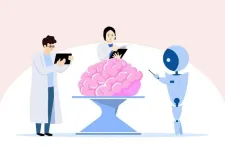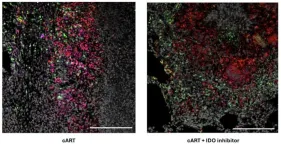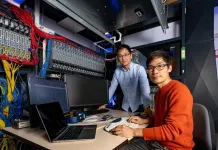Building better solar cells: assembly of 2D molecular structures with triptycene scaffold
2D assemblies of pentacene constructed using the supramolecular scaffold demonstrated high efficiency in singlet fission, a process that can enhance solar cell performance
2024-10-01
(Press-News.org)
Research in the field of material science and electronics relies on the innovative arrangement of molecules or atoms to develop materials with unique properties not found in conventional materials. Two-dimensional (2D) assemblies of π-electronic systems, arranged in thin layers, are becoming increasingly important in the fields of materials science and organic electronics. Their unique arrangement allows for specific electronic and physical properties, making them ideal for applications like solar cells, and flexible displays. However, creating such assemblies is challenging because it often requires special designs and techniques for each type of molecule.
In a study published in Science Advances, on 13 September 2024, Assistant Professor Tomoya Fukui and Professor Takanori Fukushima from Institute of Science Tokyo, in collaboration with Professor Taku Hasobe from Keio University, present a streamlined approach using supramolecular scaffolds. These scaffolds serve as molecular templates, allowing for the assembly of various molecules into 2D structures without requiring custom setups for each component.
The researchers used 1,8,13-substituted tripodal triptycene as a supramolecular scaffold. Tripodal triptycene-based supramolecular scaffold can assemble into a 2D hexagonal pattern that can be stacked along one dimension, creating a “2D + 1D” structure. The space between these layers can accommodate other molecules. In their earlier work, the team incorporated spherical fullerene (C60) molecules within these layers. In their latest study, they demonstrated that this scaffold could also organize planar acene chromophores by sandwiching pentacene and anthracene chromophores between two triptycene units, forming two distinct 2D self-assembling structures.
Acenes were selected due to their potential for singlet fission (SF). In this process, a single high-energy photon is converted into two lower-energy triplet excitons, which is expected to enhance solar cell efficiency by increasing charge carriers. Dr. Fukui notes that for efficient singlet fission in the solid state, two conditions must be met: “Acene chromophores need to be placed in close proximity to each other to provide sufficient electronic coupling. Second, the environment around the chromophores needs to be designed to allow them to undergo conformational changes to prevent triplet recombination.”
In the pentacene-based assemblies, the effective overlap of chromophores enabled singlet fission to occur, with a high quantum yield of 88% for generating a pair of triplets and 130% for producing two free triplets. However, the anthracene-based assemblies did not exhibit singlet fission, likely due to weaker electronic coupling between the chromophores.
“Pentacene chromophores, which have a size larger than that of the diameter of the triptycene framework, have effective overlap to cause SF, while such an overlap between the chromophores does not occur in the assembly of anthracene analog,” explains Prof. Fukushima.
Such assemblies can be integrated into comb-shaped electrodes, potentially paving to the way for device applications. “This demonstrates the utility of the triptycene-based supramolecular scaffold to design functional pi-electronic molecular assemblies,” says Prof. Hasobe. The scaffold's adaptable design offers a versatile platform for constructing 2D assemblies with different molecules, paving the way for advancements in supramolecular chemistry, materials science, and organic electronics.
###
About Institute of Science Tokyo
Institute of Science Tokyo (Science Tokyo) was established on October 1, 2024, following the merger between Tokyo Medical and Dental University (TMDU) and Tokyo Institute of Technology (Tokyo Tech), with the mission of “Advancing science and human wellbeing to create value for and with society.
END
[Attachments] See images for this press release:
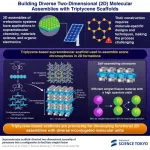
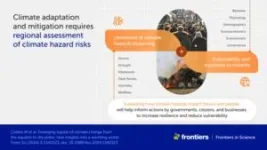
ELSE PRESS RELEASES FROM THIS DATE:
2024-10-01
A new paper in the Journal of the National Cancer Institute, published by Oxford University Press, indicates that patients may benefit if doctors stop calling certain early-stage changes to the prostate “cancer” at all.
Prostate cancer is the second leading cause of cancer death worldwide in men, but far more patients are diagnosed than die of the disease. In 2022, there were nearly 1.5 million cases of prostate cancer, but only 400,000 deaths. Low-grade prostate cancer, commonly known as GG1 among physicians, virtually never metastasizes or causes symptoms. Some medical researchers have wondered recently if it would be a benefit ...
2024-10-01
We don’t all age at the same rate. But while some supercentenarians may age exceptionally slowly due to winning the genetics jackpot, a plethora of behavioral and lifestyle factors are known to speed up aging, including stress, poor sleep, poor nutrition, smoking, and alcohol. Since such environmental effects get imprinted on our genome in the form of epigenetic marks, it is possible to quantify molecular aging by characterizing the epigenome at prognostic genomic sites.
Over the past decade, scientists have developed several such ‘epigenetic clocks’, calibrated against chronological age and various lifestyle factors across large ...
2024-10-01
As artificial intelligence advances, its uses and capabilities in real-world applications continue to reach new heights that may even surpass human expertise. In the field of radiology, where a correct diagnosis is crucial to ensure proper patient care, large language models, such as ChatGPT, could improve accuracy or at least offer a good second opinion.
To test its potential, graduate student Yasuhito Mitsuyama and Associate Professor Daiju Ueda’s team at Osaka Metropolitan University’s Graduate ...
2024-10-01
SAN ANTONIO (October 1, 2024) – A therapy showing promise to help control tuberculosis (TB) does not interfere with combined antiretroviral therapy (cART), according to research by Texas Biomedical Research Institute (Texas Biomed).
“This is an important hurdle that this host-directed therapy had to clear in order to help patients battling both HIV and TB,” said Texas Biomed Professor Smriti Mehra, Ph.D., who led the study recently published in the peer-reviewed journal JCI Insight.
TB is responsible for more than 1.3 million deaths worldwide every year. Dr. Mehra ...
2024-10-01
Media Contacts:
Alex Hulvalchick, 630-626-6282
Lisa Robinson, 630-626-6084, lrobinson@aap.org
American Academy of Pediatrics Examines the Impact of School Expulsion and Recommends Ways to Create Supportive Learning Environments for All Students
Updated policy statement on school suspension to be released during the AAP 2024 National Conference & Exhibition in Orlando.
ORLANDO, Fla.--Suspending or expelling a student is one of the most severe punishments a school can impose on a student – and it can have lifelong, devastating consequences. ...
2024-10-01
A study of more than 28,000 pregnancies from 2022 has found that the majority of pregnant people received the COVID-19 vaccine during its initial release.
The study, co-led by McMaster University and the University of British Columbia, used data from ICES, an independent, not-for-profit research institute, to provide insight into vaccination rates among one of the groups most vulnerable to health complications caused by COVID-19.
The research, published in the Canadian Medical Association Journal (CMAJ) ...
2024-10-01
A human rights-based approach to coral reef protection could ensure governments are held to account for safeguarding marine ecosystems and empower local and Indigenous communities to demand sustainable solutions and climate justice, a new study suggests.
An estimated one billion people rely on healthy coral reefs globally for food security, coastal protection and income from tourism and other services. If reefs and their ecosystems are lost, the impact on human health and economic wellbeing would be catastrophic.
Lead ...
2024-10-01
The Hunga Tonga underwater volcano was one of the largest volcanic eruptions in history, and now, two years later, new research from The Australian National University (ANU) has revealed its main trigger.
Until now, the cause of the cataclysmic event has remained largely a mystery to the scientific community, yet a student-led team of ANU seismologists has been able to shed new light on the natural explosion that initiated the event.
The student researchers analysed the climactic event’s noisy but valuable seismic ...
2024-10-01
A gene that limits cellular damage could be the key to surviving prolonged cold exposure.
Researchers have identified a gene that enables mammalian cells to survive for long periods at extremely low temperature, which animals experience during hibernation.
Body temperatures below 10 degrees Celsius (°C) swiftly prove fatal for humans and many other mammals, because prolonged cold stress causes cells to accumulate damaging free radicals—in particular lipid peroxide radicals—resulting in cell death and organ failure. But a few mammalian species can survive cold stress by hibernating. Hibernation in many small mammals involves ...
2024-10-01
Microplastic pollution is a significant environmental problem that harms animals and people and affects ecosystems worldwide. These tiny pieces of plastic, smaller than five millimeters, are pushed by wind and water to move around the globe.
Nasrin Alamdari, an assistant professor in the FAMU-FSU College of Engineering’s Department of Civil and Environmental Engineering, is on a mission to learn more about microplastics and how they move.
In research published in Environmental Pollution, she helped examine how shape, size and density affect the speed at which ...
LAST 30 PRESS RELEASES:
[Press-News.org] Building better solar cells: assembly of 2D molecular structures with triptycene scaffold
2D assemblies of pentacene constructed using the supramolecular scaffold demonstrated high efficiency in singlet fission, a process that can enhance solar cell performance


